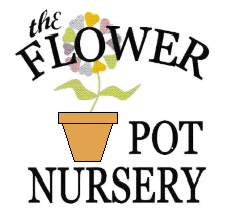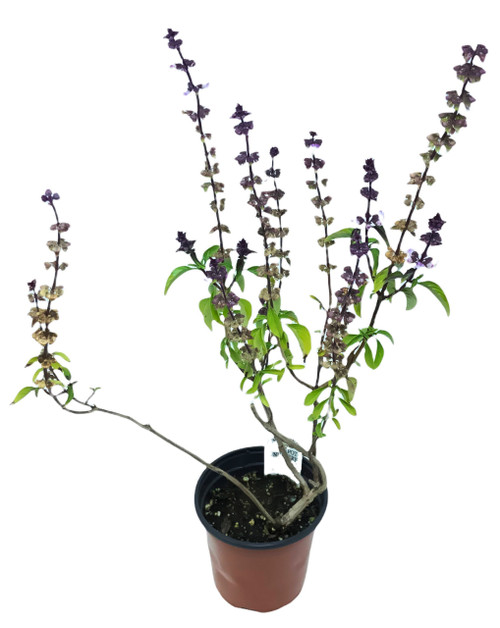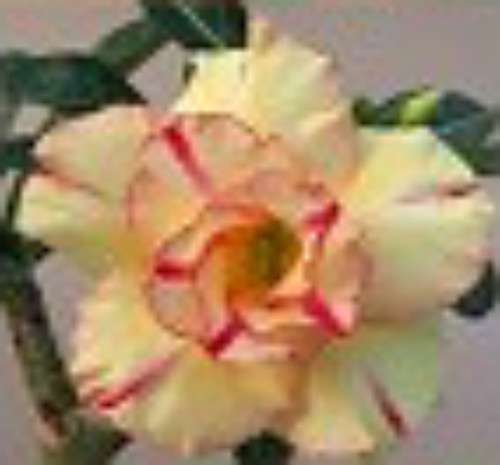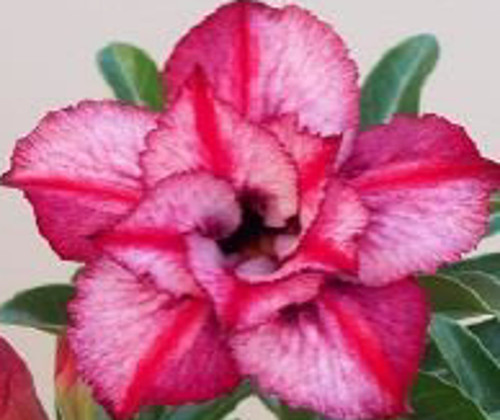Thai basil is a type of basil native to Southeast Asia that has been cultivated to provide distinctive traits. Widely used throughout Southeast Asia, its flavor, described as anise- and licorice-like and slightly spicy, is more stable under high or extended cooking temperatures than that of sweet basil. Thai basil has small, narrow leaves, purple stems, and pink-purple flowers.
Sweet basil (Ocimum basilicum) has multiple cultivars - Thai basil, O. basilicum var. thyrsiflora, is one variety. Thai basil may sometimes be called chi neang vorng, anise basil or licorice basil, in reference to its anise- and licorice-like scent and taste, but it is different from the Western strains bearing these same names.
Occasionally, Thai basil may be called cinnamon basil, which is its literal name in Vietnamese, but cinnamon basil typically refers to a separate cultivar.
The genus name Ocimum is derived from the Greek word meaning "to smell", which is appropriate for most members of the plant family Lamiaceae, also known as the mint family. With over 40 cultivars of basil, this abundance of flavors, aromas, and colors leads to confusion when identifying specific cultivars.
Thai basil, or horapha (Thai: โหระพา), is widely used throughout Southeast Asia and plays a prominent role in Vietnamese cuisine. It is the cultivar most often used for Asian cooking in Western kitchens.
Holy basil which has a spicy, peppery, clove-like taste, may be the basil Thai people love most. It is also known as Thai holy basil or by its Indian name, tulasi or tulsi; it is widely used in India for culinary, medicinal, and religious purposes.
Lemon basil (O. × citriodorum), or maenglak , as its name implies, has undertones of lemon in scent and taste. Lemon basil is the least commonly used type of basil in Thailand. It is also known as Thai lemon basil, in contradistinction to Mrs. Burns' Lemon basil, another cultivar.
In Taiwan the Thai basil is called káu-chàn-thah, which literally means "nine-storey pagoda".
Thai basil is sturdy and compact, growing up to 1 ft 6 in, and has shiny green, slightly serrated, narrow leaves with a sweet, anise-like scent and hints of licorice, along with a slight spiciness lacking in sweet basil. Thai basil has a purple stem, and like other plants in the mint family, the stem is square. Its leaves are opposite and decussate. As implied by its scientific name, Thai basil flowers in the form of a thyrse. The inflorescence is purple, and the flowers when open are pink.
Give credit where credit is due: Wikipedia 2021
Sweet basil (Ocimum basilicum) has multiple cultivars - Thai basil, O. basilicum var. thyrsiflora, is one variety. Thai basil may sometimes be called chi neang vorng, anise basil or licorice basil, in reference to its anise- and licorice-like scent and taste, but it is different from the Western strains bearing these same names.
Occasionally, Thai basil may be called cinnamon basil, which is its literal name in Vietnamese, but cinnamon basil typically refers to a separate cultivar.
The genus name Ocimum is derived from the Greek word meaning "to smell", which is appropriate for most members of the plant family Lamiaceae, also known as the mint family. With over 40 cultivars of basil, this abundance of flavors, aromas, and colors leads to confusion when identifying specific cultivars.
Thai basil, or horapha (Thai: โหระพา), is widely used throughout Southeast Asia and plays a prominent role in Vietnamese cuisine. It is the cultivar most often used for Asian cooking in Western kitchens.
Holy basil which has a spicy, peppery, clove-like taste, may be the basil Thai people love most. It is also known as Thai holy basil or by its Indian name, tulasi or tulsi; it is widely used in India for culinary, medicinal, and religious purposes.
Lemon basil (O. × citriodorum), or maenglak , as its name implies, has undertones of lemon in scent and taste. Lemon basil is the least commonly used type of basil in Thailand. It is also known as Thai lemon basil, in contradistinction to Mrs. Burns' Lemon basil, another cultivar.
In Taiwan the Thai basil is called káu-chàn-thah, which literally means "nine-storey pagoda".
Thai basil is sturdy and compact, growing up to 1 ft 6 in, and has shiny green, slightly serrated, narrow leaves with a sweet, anise-like scent and hints of licorice, along with a slight spiciness lacking in sweet basil. Thai basil has a purple stem, and like other plants in the mint family, the stem is square. Its leaves are opposite and decussate. As implied by its scientific name, Thai basil flowers in the form of a thyrse. The inflorescence is purple, and the flowers when open are pink.
Give credit where credit is due: Wikipedia 2021










